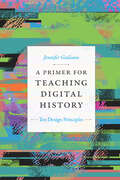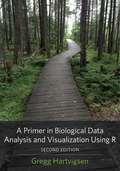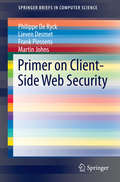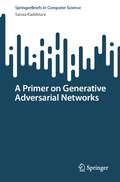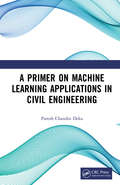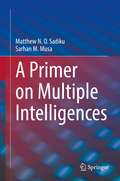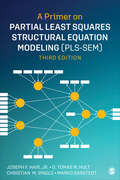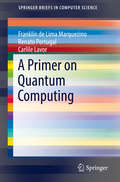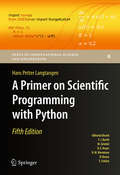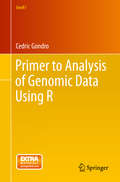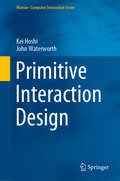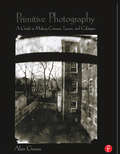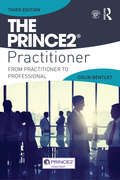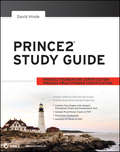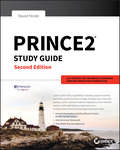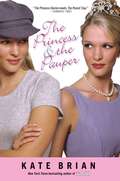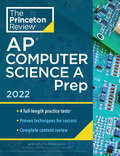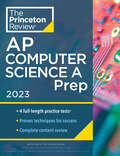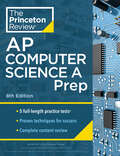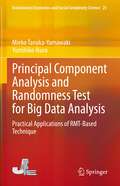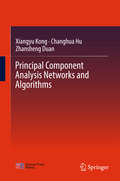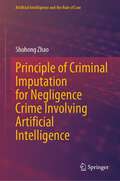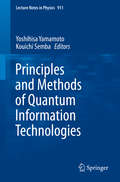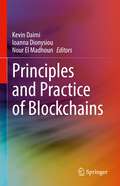- Table View
- List View
A Primer for Teaching Digital History: Ten Design Principles (Design Principles for Teaching History)
by Jennifer GuilianoA Primer for Teaching Digital History is a guide for college and high school teachers who are teaching digital history for the first time or for experienced teachers who want to reinvigorate their pedagogy. It can also serve those who are training future teachers to prepare their own syllabi, as well as teachers who want to incorporate digital history into their history courses. Offering design principles for approaching digital history that represent the possibilities that digital research and scholarship can take, Jennifer Guiliano outlines potential strategies and methods for building syllabi and curricula. Taking readers through the process of selecting data, identifying learning outcomes, and determining which tools students will use in the classroom, Guiliano outlines popular research methods including digital source criticism, text analysis, and visualization. She also discusses digital archives, exhibits, and collections as well as audiovisual and mixed-media narratives such as short documentaries, podcasts, and multimodal storytelling. Throughout, Guiliano illuminates how digital history can enhance understandings of not just what histories are told but how they are told and who has access to them.
A Primer in Biological Data Analysis and Visualization Using R
by Gregg HartvigsenR is the most widely used open-source statistical and programming environment for the analysis and visualization of biological data. Drawing on Gregg Hartvigsen’s extensive experience teaching biostatistics and modeling biological systems, this text is an engaging, practical, and lab-oriented introduction to R for students in the life sciences.Underscoring the importance of R and RStudio in organizing, computing, and visualizing biological statistics and data, Hartvigsen guides readers through the processes of correctly entering and analyzing data and using R to visualize data using histograms, boxplots, barplots, scatterplots, and other common graph types. He covers testing data for normality, defining and identifying outliers, and working with non-normally distributed data. Students are introduced to common one- and two-sample tests as well as one- and two-way analysis of variance (ANOVA), correlation, and linear and nonlinear regression analyses. This volume also includes a section on advanced procedures and a chapter outlining algorithms and the art of programming using R.This second edition has been revised to be current with the versions of R software released since the book’s original publication. It features updated terminology, sources, and examples throughout.
Primer on Client-Side Web Security
by Philippe De Ryck Lieven Desmet Frank Piessens Martin JohnsThis volume illustrates the continuous arms race between attackers and defenders of the Web ecosystem by discussing a wide variety of attacks. In the first part of the book, the foundation of the Web ecosystem is briefly recapped and discussed. Based on this model, the assets of the Web ecosystem are identified, and the set of capabilities an attacker may have are enumerated. In the second part, an overview of the web security vulnerability landscape is constructed. Included are selections of the most representative attack techniques reported in great detail. In addition to descriptions of the most common mitigation techniques, this primer also surveys the research and standardization activities related to each of the attack techniques, and gives insights into the prevalence of those very attacks. Moreover, the book provides practitioners a set of best practices to gradually improve the security of their web-enabled services. Primer on Client-Side Web Security expresses insights into the future of web application security. It points out the challenges of securing the Web platform, opportunities for future research, and trends toward improving Web security.
A Primer on Generative Adversarial Networks (SpringerBriefs in Computer Science)
by Sanaa KaddouraThis book is meant for readers who want to understand GANs without the need for a strong mathematical background. Moreover, it covers the practical applications of GANs, making it an excellent resource for beginners. A Primer on Generative Adversarial Networks is suitable for researchers, developers, students, and anyone who wishes to learn about GANs. It is assumed that the reader has a basic understanding of machine learning and neural networks. The book comes with ready-to-run scripts that readers can use for further research. Python is used as the primary programming language, so readers should be familiar with its basics.The book starts by providing an overview of GAN architecture, explaining the concept of generative models. It then introduces the most straightforward GAN architecture, which explains how GANs work and covers the concepts of generator and discriminator. The book then goes into the more advanced real-world applications of GANs, such as human face generation, deep fake, CycleGANs, and more.By the end of the book, readers will have an essential understanding of GANs and be able to write their own GAN code. They can apply this knowledge to their projects, regardless of whether they are beginners or experienced machine learning practitioners.
A Primer on Machine Learning Applications in Civil Engineering
by Paresh Chandra DekaMachine learning has undergone rapid growth in diversification and practicality, and the repertoire of techniques has evolved and expanded. The aim of this book is to provide a broad overview of the available machine-learning techniques that can be utilized for solving civil engineering problems. The fundamentals of both theoretical and practical aspects are discussed in the domains of water resources/hydrological modeling, geotechnical engineering, construction engineering and management, and coastal/marine engineering. Complex civil engineering problems such as drought forecasting, river flow forecasting, modeling evaporation, estimation of dew point temperature, modeling compressive strength of concrete, ground water level forecasting, and significant wave height forecasting are also included. Features Exclusive information on machine learning and data analytics applications with respect to civil engineering Includes many machine learning techniques in numerous civil engineering disciplines Provides ideas on how and where to apply machine learning techniques for problem solving Covers water resources and hydrological modeling, geotechnical engineering, construction engineering and management, coastal and marine engineering, and geographical information systems Includes MATLAB® exercises
A Primer on Multiple Intelligences
by Sarhan M. Musa Matthew N. SadikuThis book provides an introduction to nineteen popular multiple intelligences. Part One discusses general intelligence, psychological testing, naturalistic intelligence, social intelligence, emotional intelligence, interpersonal intelligence, and cultural intelligence. Part Two tackles machine intelligence, the development of artificial intelligence, computational intelligence, and digital intelligence, or the ability for humans to adapt to a digital environment. Finally, Part Three discusses the role of intelligence in business development, using technology to augment intelligence, abstract thinking, swarm and animal intelligence, military intelligence, and musical intelligence. A Primer on Multiple Intelligences is a must-read for graduate students or scholars considering researching cognition, perception, motivation, and artificial intelligence. It will also be of use to those in social psychology, computer science, and pedagogy. It is as a valuable resource for anyone interested in learning more about the multifaceted study of intelligence.
A Primer on Partial Least Squares Structural Equation Modeling (PLS-SEM)
by Joe Hair G. Tomas Hult Christian M. Ringle Marko SarstedtThe third edition of A Primer on Partial Least Squares Structural Equation Modeling (PLS-SEM) guides readers through learning and mastering the techniques of this approach in clear language. Authors Joseph H. Hair, Jr., G. Tomas M. Hult, Christian Ringle, and Marko Sarstedt use their years of conducting and teaching research to communicate the fundamentals of PLS-SEM in straightforward language to explain the details of this method, with limited emphasis on equations and symbols. A running case study on corporate reputation follows the different steps in this technique so readers can better understand the research applications. Learning objectives, review and critical thinking questions, and key terms help readers cement their knowledge. This edition has been thoroughly updated, featuring the latest version of the popular software package SmartPLS 3. New topics have been added throughout the text, including a thoroughly revised and extended chapter on mediation, recent research on the foundations of PLS-SEM, detailed descriptions of research summarizing the advantages as well as limitations of PLS-SEM, and extended coverage of advanced concepts and methods, such as out-of-sample versus in-sample prediction metrics, higher-order constructs, multigroup analysis, necessary condition analysis, and endogeneity.
A Primer on Partial Least Squares Structural Equation Modeling (PLS-SEM)
by Joe Hair G. Tomas Hult Christian M. Ringle Marko SarstedtThe third edition of A Primer on Partial Least Squares Structural Equation Modeling (PLS-SEM) guides readers through learning and mastering the techniques of this approach in clear language. Authors Joseph H. Hair, Jr., G. Tomas M. Hult, Christian Ringle, and Marko Sarstedt use their years of conducting and teaching research to communicate the fundamentals of PLS-SEM in straightforward language to explain the details of this method, with limited emphasis on equations and symbols. A running case study on corporate reputation follows the different steps in this technique so readers can better understand the research applications. Learning objectives, review and critical thinking questions, and key terms help readers cement their knowledge. This edition has been thoroughly updated, featuring the latest version of the popular software package SmartPLS 3. New topics have been added throughout the text, including a thoroughly revised and extended chapter on mediation, recent research on the foundations of PLS-SEM, detailed descriptions of research summarizing the advantages as well as limitations of PLS-SEM, and extended coverage of advanced concepts and methods, such as out-of-sample versus in-sample prediction metrics, higher-order constructs, multigroup analysis, necessary condition analysis, and endogeneity.
A Primer on Quantum Computing (SpringerBriefs in Computer Science)
by Renato Portugal Carlile Lavor Franklin de Lima MarquezinoThis book is about quantum computing and quantum algorithms. The book starts with a chapter introducing the basic rules of quantum mechanics and how they can be used to build quantum circuits and perform computations.Further, Grover's algorithm is presented for unstructured search discussing its consequences and applications. Next, important techniques are discussed such as Quantum Fourier Transform and quantum phase estimation. Finally, Shor's algorithm for integer factorization is explained.At last, quantum walks are explained in detail covering both the discrete and continuous time models,and applications of this techniques are described for the design and analyses of quantum algorithms.
A Primer on Scientific Programming with Python (Texts in Computational Science and Engineering #6)
by Hans Petter LangtangenThe book serves as a first introduction to computer programming of scientific applications, using the high-level Python language. The exposition is example and problem-oriented, where the applications are taken from mathematics, numerical calculus, statistics, physics, biology and finance. The book teaches "Matlab-style" and procedural programming as well as object-oriented programming. High school mathematics is a required background and it is advantageous to study classical and numerical one-variable calculus in parallel with reading this book. Besides learning how to program computers, the reader will also learn how to solve mathematical problems, arising in various branches of science and engineering, with the aid of numerical methods and programming. By blending programming, mathematics and scientific applications, the book lays a solid foundation for practicing computational science. From the reviews: Langtangen . . . does an excellent job of introducing programming as a set of skills in problem solving. He guides the reader into thinking properly about producing program logic and data structures for modeling real-world problems using objects and functions and embracing the object-oriented paradigm. . . . Summing Up: Highly recommended. F. H. Wild III, Choice, Vol. 47 (8), April 2010 Those of us who have learned scientific programming in Python 'on the streets' could be a little jealous of students who have the opportunity to take a course out of Langtangen's Primer. " John D. Cook, The Mathematical Association of America, September 2011 This book goes through Python in particular, and programming in general, via tasks that scientists will likely perform. It contains valuable information for students new to scientific computing and would be the perfect bridge between an introduction to programming and an advanced course on numerical methods or computational science. Alex Small, IEEE, CiSE Vol. 14 (2), March /April 2012
Primer to Analysis of Genomic Data Using R
by Cedric GondroThrough this book, researchers and students will learn to use R for analysis of large-scale genomic data and how to create routines to automate analytical steps. The philosophy behind the book is to start with real world raw datasets and perform all the analytical steps needed to reach final results. Though theory plays an important role, this is a practical book for graduate and undergraduate courses in bioinformatics and genomic analysis or for use in lab sessions. How to handle and manage high-throughput genomic data, create automated workflows and speed up analyses in R is also taught. A wide range of R packages useful for working with genomic data are illustrated with practical examples. The key topics covered are association studies, genomic prediction, estimation of population genetic parameters and diversity, gene expression analysis, functional annotation of results using publically available databases and how to work efficiently in R with large genomic datasets. Important principles are demonstrated and illustrated through engaging examples which invite the reader to work with the provided datasets. Some methods that are discussed in this volume include: signatures of selection, population parameters (LD, FST, FIS, etc); use of a genomic relationship matrix for population diversity studies; use of SNP data for parentage testing; snpBLUP and gBLUP for genomic prediction. Step-by-step, all the R code required for a genome-wide association study is shown: starting from raw SNP data, how to build databases to handle and manage the data, quality control and filtering measures, association testing and evaluation of results, through to identification and functional annotation of candidate genes. Similarly, gene expression analyses are shown using microarray and RNAseq data. At a time when genomic data is decidedly big, the skills from this book are critical. In recent years R has become the de facto
Primitive Interaction Design (Human–Computer Interaction Series)
by Kei Hoshi John WaterworthInteraction design is acknowledged as an important area of study, and more especially of design practice. Hugely popular and profitable consumer devices, such as mobile phones and tablets, are seen as owing much of their success to the way they have been designed, not least their interface characteristics and the styles of interaction that they support. Interaction design studies point to the importance of a user-centred approach, whereby products are in principle designed around their future users’ needs and capacities. However, it is the market, and marketing, that determine which products are available for people to interact with and to a great extent what their designed characteristics are. Primitive Interaction Design is based on the realisation that designers need to be freed from the marketplace and industry pressure, and that the usual user-centred arguments are not enough to make a practical difference. Interaction designers are invited to cast themselves as “savages”, as if wielding primitive tools in concrete physical environments. A theoretical perspective is presented that opens up new possibilities for designers to explore fresh ideas and practices, including the importance of conscious and unconscious being, emptiness and trickery. Building on this, a set of design tools for primitive design work is presented and illustrated with practical examples. This book will be of particular interest to undergraduate and graduate students and researchers in interaction design and HCI, as well as practicing interaction designers and computer professions. It will also appeal to those with an interest in psychology, anthropology, cultural studies, design and the future of technology in society.
Primitive Photography: A Guide to Making Cameras, Lenses, and Calotypes (Alternative Process Photography Ser.)
by Alan GreenePrimitive Photography considers the hand-made photographic process in its entirety, showing the reader how to make box-cameras, lenses, paper negatives and salt prints, using inexpensive tools and materials found in most hardware and art-supply stores. Step-by-step procedures are presented alongside theoretical explanations and historical background. Streamlined calotype procedures are demonstrated, featuring different paper negative processes and overlooked, developing-out printing methods. Primitive Photography combines the simplicity of pinhole photography, the handmade quality of alternative processes, and the precision of large-format. For those seeking alternatives to commercially prepared material as well as digital photography, it provides the instructions for creating the entire photographic process from the ground up. Given its scope and treatment of the photographic process as a whole, this may be the first book of its kind to appear in over a century.
The PRINCE2 Practitioner: From Practitioner to Professional
by Colin BentleyStruggling to apply the principles of PRINCE2 in practice? Need guidance on adapting the process for smaller projects? PRINCE2 for Practitioners provides the solution. This practical reference, matching the details and requirements of the 2009 PRINCE2 manual, contains new and updated real-life examples and case studies, links between related components and processes, and clear guidance on how to fine-tune the method to help you manage projects successfully, whatever the context and size. An affordable alternative to expensive training, this best-selling handbook by PRINCE2 expert Colin Bentley is an indispensable addition to your project management bookshelf and a companion to the PRINCE2 for Beginners book. If you have passed the PRINCE2 exams, it will help you keep your knowledge and skills up to date to maintain registered status and enable you to apply the theory of PRINCE2 to everyday project work after certification.
PRINCE2 Study Guide
by David HindeEverything you need to be fully prepared to take the PRINCE2 Foundation and Practitioner examAs an internationally recognized certification which focuses on the Foundation and Practitioner levels along with being recommended by the Project Management Institute, the PRINCE2 accreditation gives a bolster to any resume.The author, David Hinde, has trained hundreds of individuals from many different backgrounds to prepare for the PRINCE2 exams. The book provides explanations of all parts of the PRINCE2 approach, lots of practical examples, and a whole range of mock examination questions to test your knowledge.Explains all the PRINCE2 themes, processes, principles, roles and management products for the very latest version of PRINCE2 (PRINCE2 2009 Edition)Features full coverage of all Foundation and Practitioner level exam objectivesPresents real-world scenarios, showing how the method is used in business and the public sectorIncludes challenging review questions and electronic flashcards to sharpen your knowledgeCovers tips and techniques for tackling the PRINCE2 accreditation examinations and shows you how and where to take the examsIncorporates over 300 sample Foundation-level and over 100 sample Practitioner-level questions, with answers and full explanationsContains a glossary of all PRINCE2 terminology and a quick reference to all the PRINCE2 management productsGives a web link to a set of on-line tools with more bonus examsPRINCE2 Study Guide covers all the necessary topics you need to know in order to confidently take the PRINCE2 Foundation and Practitioner exams.
PRINCE2 Study Guide: 2017 Update
by David HindeEverything you need to pass the PRINCE2 with flying colors The PRINCE2 Study Guide, Second Edition, offers comprehensive preparation for the latest PRINCE2 exam. Covering 100 percent of the exam objectives, this guide provides invaluable guidance that will help you master both the material and its applications; indeed, a practice-centered approach helps you “learn by doing” to help you internalize PRINCE2 concepts on a deeper level. Although the exam is heavily focused on detailed business process, this guide’s accessible writing and real-world approach make learning fun. Each chapter poses a common project challenge, and walks you through the solution based on essential PRINCE2 principles. A year of FREE access to electronic study aids allows you to study anywhere, at any time, and expert instruction throughout breaks complex topics down into easily-digestible concepts. The PRINCE2 exam is challenging, but thorough preparation is your best defense. Conceptual knowledge is important, but it isn’t enough—knowledge is only useful if you can apply it. This book is designed as your personal PRINCE2 coach: Master 100 percent of the PRINCE2 exam objectives Apply your knowledge to real-world workplace scenarios Test your understanding with challenging review questions Access sample questions, electronic flashcards, and other study aids PRINCE2 is globally recognized as one of the premier project management credentials; while less expansive than the PMP, the PRINCE2 is more intense and tightly focused on detailed business processes. Companies around the world are in need of qualified project management professionals to optimize processes and boost organizational performance—and the PRINCE2 certification puts you on the map as a validated professional. If you’re ready to take on your next challenge, the PRINCE2 Study Guide, Second Edition, is your ultimate companion for complete preparation.
The Princess and the Pauper
by Kate BrianCarina, a real European princess, is dying to hook up with the sexy American rock star she met online. Too bad about all those bodyguards watching her every move. Then Carina spots her down-and-out near-twin, Julia. For a fast ten grand, Julia grabs the gown and the crown, and the girls swap identities for a day. Before long Princess Carina is trapped on a sketchy bus full of roadies, and pauper Julia is jetting off to... some small foreign country? Only a storybook ending can get these two poseurs back to where they belong.
Princeton Review AP Computer Science A Prep, 2022: 4 Practice Tests + Complete Content Review + Strategies & Techniques (College Test Preparation)
by The Princeton ReviewEVERYTHING YOU NEED TO SCORE A PERFECT 5. Ace the 2022 AP Computer Science A Exam with this comprehensive study guide, which includes 4 full-length practice tests, thorough content reviews, targeted strategies for every section of the exam, and access to online extras. Techniques That Actually Work. • Tried-and-true strategies to help you avoid traps and beat the test • Tips for pacing yourself and guessing logically • Essential tactics to help you work smarter, not harder Everything You Need to Know to Help Achieve a High Score. • Fully aligned with the latest College Board standards for AP® Computer Science A • Comprehensive content review for all test topics, including lab requirements • Engaging activities to help you critically assess your progress • Access to study plans, printable resources, helpful pre-college information, and more via your online Student Tools Practice Your Way to Excellence. • 4 full-length practice tests (3 in the book, 1 online) with detailed answer explanations • Comprehension drills in each content review chapter • Step-by-step walk-throughs of sample questions
Princeton Review AP Computer Science A Prep, 2023: 4 Practice Tests + Complete Content Review + Strategies & Techniques (College Test Preparation)
by The Princeton ReviewEVERYTHING YOU NEED TO SCORE A PERFECT 5. Ace the 2023 AP Computer Science A Exam with this comprehensive study guide, which includes 4 full-length practice tests, thorough content reviews, targeted strategies for every section of the exam, and access to online extras. Techniques That Actually Work • Tried-and-true strategies to help you avoid traps and beat the test • Tips for pacing yourself and guessing logically • Essential tactics to help you work smarter, not harder Everything You Need for a High Score • Fully aligned with the latest College Board standards for AP® Computer Science A • Comprehensive content review for all test topics, including lab requirements • Engaging activities to help you critically assess your progress • Access to study plans, printable resources, helpful pre-college information, and more via your online Student Tools Practice Your Way to Excellence • 4 full-length practice tests (3 in the book, 1 online) with detailed answer explanations • Comprehension drills in each content review chapter • Step-by-step walk-throughs of sample questions
Princeton Review AP Computer Science A Prep, 8th Edition: 5 Practice Tests + Complete Content Review + Strategies & Techniques (College Test Preparation)
by The Princeton ReviewEVERYTHING YOU NEED TO SCORE A PERFECT 5. Ace the AP Computer Science A Exam with this comprehensive study guide, which includes 5 full-length practice tests, thorough content reviews, targeted strategies for every section of the exam, and access to online extras.Techniques That Actually Work• Tried-and-true strategies to help you avoid traps and beat the test• Tips for pacing yourself and guessing logically• Essential tactics to help you work smarter, not harderEverything You Need for a High Score• Fully aligned with the latest College Board standards for AP® Computer Science A• Comprehensive content review for all test topics, including lab requirements• Engaging activities to help you critically assess your progress• Access to study plans, printable resources, helpful pre-college information, and more via your online Student ToolsPractice Your Way to Excellence• 5 full-length practice tests (3 in the book, 2 online) with detailed answer explanations• Comprehension drills in each content review chapter• Step-by-step walk-throughs of sample questions
Principal Component Analysis and Randomness Test for Big Data Analysis: Practical Applications of RMT-Based Technique (Evolutionary Economics and Social Complexity Science #25)
by Mieko Tanaka-Yamawaki Yumihiko IkuraThis book presents the novel approach of analyzing large-sized rectangular-shaped numerical data (so-called big data). The essence of this approach is to grasp the "meaning" of the data instantly, without getting into the details of individual data. Unlike conventional approaches of principal component analysis, randomness tests, and visualization methods, the authors' approach has the benefits of universality and simplicity of data analysis, regardless of data types, structures, or specific field of science. First, mathematical preparation is described. The RMT-PCA and the RMT-test utilize the cross-correlation matrix of time series, C = XXT, where X represents a rectangular matrix of N rows and L columns and XT represents the transverse matrix of X. Because C is symmetric, namely, C = CT, it can be converted to a diagonal matrix of eigenvalues by a similarity transformation SCS-1 = SCST using an orthogonal matrix S. When N is significantly large, the histogram of the eigenvalue distribution can be compared to the theoretical formula derived in the context of the random matrix theory (RMT, in abbreviation). Then the RMT-PCA applied to high-frequency stock prices in Japanese and American markets is dealt with. This approach proves its effectiveness in extracting "trendy" business sectors of the financial market over the prescribed time scale. In this case, X consists of N stock- prices of length L, and the correlation matrix C is an N by N square matrix, whose element at the i-th row and j-th column is the inner product of the price time series of the length L of the i-th stock and the j-th stock of the equal length L. Next, the RMT-test is applied to measure randomness of various random number generators, including algorithmically generated random numbers and physically generated random numbers. The book concludes by demonstrating two applications of the RMT-test: (1) a comparison of hash functions, and (2) stock prediction by means of randomness, including a new index of off-randomness related to market decline.
Principal Component Analysis Networks and Algorithms
by Xiangyu Kong Changhua Hu Zhansheng DuanThis book not only provides a comprehensive introduction to neural-based PCA methods in control science, but also presents many novel PCA algorithms and their extensions and generalizations, e. g. , dual purpose, coupled PCA, GED, neural based SVD algorithms, etc. It also discusses in detail various analysis methods for the convergence, stabilizing, self-stabilizing property of algorithms, and introduces the deterministic discrete-time systems method to analyze the convergence of PCA/MCA algorithms. Readers should be familiar with numerical analysis and the fundamentals of statistics, such as the basics of least squares and stochastic algorithms. Although it focuses on neural networks, the book only presents their learning law, which is simply an iterative algorithm. Therefore, no a priori knowledge of neural networks is required. This book will be of interest and serve as a reference source to researchers and students in applied mathematics, statistics, engineering, and other related fields.
Principle of Criminal Imputation for Negligence Crime Involving Artificial Intelligence (Artificial Intelligence and the Rule of Law)
by Shuhong ZhaoThis book provides an in-depth discussion of the theoretical and practical issues of criminal imputation for negligence crime involving artificial intelligence. Accordingly, this study combines the imputation challenges brought about by AI with traditional criminal imputation theory and analyses imputation for negligence crime involving AI from three aspects: the basic principles, structure, and results of imputation for negligence crime involving AI. The traditional theory of imputation is discussed in detail. The readership is a group of people interested in this topic, including, in particular, interested laymen, undergraduate students and postgraduate researchers. The highlights of this book are it identifies the imputation challenges bought about by AI, reveals the theoretical and practical gap in the criminal imputation of negligent crimes involving AI, and provides an in-depth and creative ideas of criminal imputation for the negligent crimes involving AI.
Principles and Methods of Quantum Information Technologies
by Yoshihisa Yamamoto Kouichi SembaThis book presents the research and development-related results of the "FIRST" Quantum Information Processing Project, which was conducted from 2010 to 2014 with the support of the Council for Science, Technology and Innovation of the Cabinet Office of the Government of Japan. The project supported 33 research groups and explored five areas: quantum communication, quantum metrology and sensing, coherent computing, quantum simulation, and quantum computing. The book is divided into seven main sections. Parts I through V, which consist of twenty chapters, focus on the system and architectural aspects of quantum information technologies, while Parts VI and VII, which consist of eight chapters, discuss the superconducting quantum circuit, semiconductor spin and molecular spin technologies. Readers will be introduced to new quantum computing schemes such as quantum annealing machines and coherent Ising machines, which have now arisen as alternatives to standard quantum computers and are designed to successfully address NP-hard/NP-complete combinatorial optimization problems, which are ubiquitous and relevant in our modern life. The book offers a balanced mix of theory-based and experimentation-based chapters written by leading researchers. Extensive information is provided on Quantum simulation, which focuses on the implementation of various many-body Hamiltonians in a well-controlled physical system, Quantum key distribution, Quantum repeaters and quantum teleportation, which are indispensable technologies for building quantum networks with various advanced applications and require far more sophisticated experimental techniques to implement.
Principles and Practice of Blockchains
by Kevin Daimi Ioanna Dionysiou Nour El MadhounThis book provides an essential compilation of relevant and cutting edge academic and industry work on key Blockchain topics. This book concentrates on a wide range of advances related to Blockchains which include, among others, Blockchain principles, architecture and concepts with emphasis on key and innovative theories, methodologies, schemes and technologies of Blockchain, Blockchain platforms and architecture, Blockchain protocols, sensors and devices for Blockchain, Blockchain foundations, and reliability analysis of Blockchain-based systems. Further, it provides a glimpse of future directions where cybersecurity applications are headed. The book is a rich collection of carefully selected and reviewed manuscripts written by diverse cybersecurity application experts in the listed fields and edited by prominent cybersecurity applications researchers and specialists.
